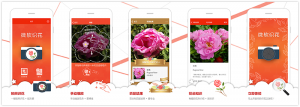The Flower Recognition app is really as straightforward as it sounds — take a picture of a flower, and our app will tell you its common name, as well as a few other details. Simple!
The Chinese version of this page can be found here

Created for iOS, Flower Reco is local only — no online connection is required, so feel free to take it with you on a mountain hike, or anywhere a data connection may be iffy.
The Flower Recognition App is No Longer Available
The Flower Recognition app was available from the App Store, and required iOS 8.2 to iOS 9.3.5. iOS 10 users may have had issues with the app — see Release Notes for details.
The first version is Chinese only. However, each flower’s English name is included in the results, so English speakers could still get some useful info. And the screens are easy for anyone to navigate.
Get Support for Flower Recognition
If you need help or have some feedback for the team you can email us at Flower Reco Support.
How To Use
First take a picture of a flower, or choose an existing photo from your Camera Roll.

Resize the image so the Flower completely fills the screen.

At this point you should get a recognition result. Tapping the ribbon will show other similar flowers.

Tap anywhere on the card to see more details about the flower.

You can share your results to other apps on your phone. Or you can send us Feedback about the recognition result.

Who are We?

Flower Descriptions and photos were provided by Suliya Ma of the Beijing Forestry University; Liu Bing, Lin Qinwen, and Cai Wentao of the Chinese Academy of Science; Chen Bin and Wang Yuan of the Shanghai Chen Shan Botanical Garden; Xu Yechun of the Guangdong Academy of Agricultural Sciences; Zhang Jinlong of the Kadoorie Farm and Botanical Garden of Hong Kong; and Liu Bo of the Minzu University of China.

